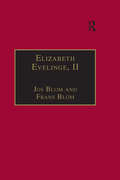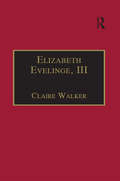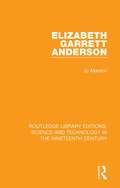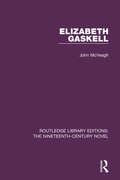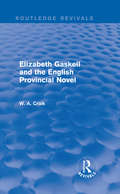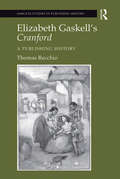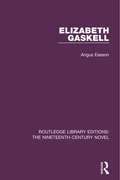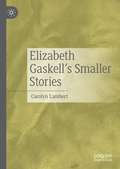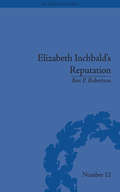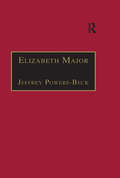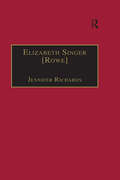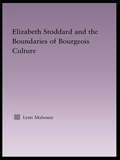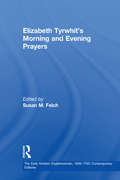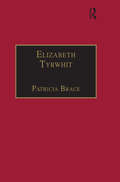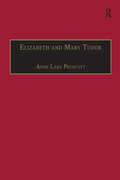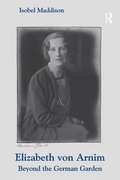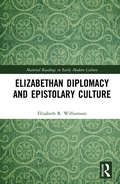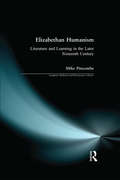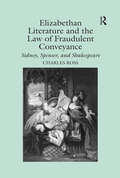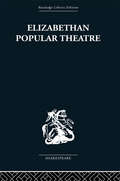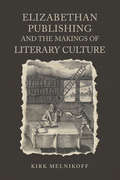- Table View
- List View
Elizabeth Evelinge, II: Printed Writings 1500–1640: Series I, Part Three, Volume 5 (The Early Modern Englishwoman: A Facsimile Library of Essential Works & Printed Writings, 1500-1640: Series I, Part Three #Pt. 3)
by Jos BlomThe declarations and ordinances made upon the rule of our holy mother S.Clare is an English translation of papal pronouncements upon the rules governing the convents of the Franciscan Order of St Clare. Elizabeth Evelinge's 176-page English version was published by one of the most prolific presses of the 17th-century English Roman Catholic exiles, the English College Press at St Omer. The edition, which was presumably very limited, was meant for English nuns living in monasteries in Flanders and Northern France. At her death, Elizabeth Evelinge was described as having 'a more polish'd way of writing above her sex. Her translation of The declarations at the age of just 25, testifies to her skills. The copy of the text reproduced here is that held at the Franciscan Library at Killiney.
Elizabeth Evelinge, III: Printed Writings 1500–1640: Series I, Part Four, Volume 1 (The Early Modern Englishwoman: A Facsimile Library of Essential Works & Printed Writings, 1500-1640: Series I, Part Four)
by Claire WalkerElizabeth Evelinge, now firmly believed to have been the translator of The admirable life of the holy virgin S. Catharine of Bologna, entered the English Poor Clare monastery in Gravelines in 1620. After ongoing dissension at Gravelines, along with Catharine Bentley (originally believed to be the translator) she founded a new cloister at Aire. Evelinge served as abbess here for 25 years. Her 1621 translation of Catharine of Bologna's life and Spiritual weapons, with their exemplary advice about how to survive the temptations and conflicts of cloistered life, aimed at assisting the troubled English Poor Clares in their time of need. Whether designed to further the Franciscan cause within the cloister or simply to offer solace, the translation of this text occurred because of the dissension in the house at Gravelines. Moreover, it is possible that Catharine of Bologna represented so compelling a model of Poor Clare spirituality that Elizabeth Evelinge, whose piety and talents mirrored those of her subject, deemed herself too humble to ascribe her intellectual achievements to herself, which led to the debate about who translated the text.
Elizabeth Garrett Anderson (Routledge Library Editions: Science and Technology in the Nineteenth Century #5)
by Jo MantonFirst published in 1965. In 1865, a woman first obtained a legal qualification in this country as physician and surgeon. Elizabeth Garrett surprised public opinion by the calm obstinacy with which she fought for her own medical education and that of the young women who followed her. This full biography is based largely on unpublished material from the hospitals and medical schools where Elizabeth Garrett Anderson worked, and the private papers of the Garrett and Anderson families. This title will be of great interest to history of science students.
Elizabeth Gaskell (Routledge Library Editions: The Nineteenth-Century Novel #26)
by John McVeaghFirst published in 1970, this study demonstrates both the range and essential unity of the works of Mrs. Gaskell. The author analyses the novels of social criticism, the biography of Charlotte Brontë and the novels of country life as distinct expressions of her genius, commenting on recurrent themes, typical methods of presentation and consistent attitudes as they appear in each of the works. The differences of subject and intention between the three kinds of writing will be seen in the extracts which indicate the range of her ability and interests. The final section summarises her range and success and failure. This book will be of interest to students of literature and sociological history.
Elizabeth Gaskell and the English Provincial Novel (Routledge Revivals)
by W. A. CraikFirst published in 1975, this book places Elizabeth Gaskell amongst the major novelists of the nineteenth-century. It considers how she has sometimes been overlooked, or admired for very few of her works, or for reasons that are not in fact central to her art. W. A. Craik looks at Gaskell’s full-length novels with three main purposes: to analyse her development as a novelist, her achievements, and the nature of her very original work; to see what she owes to earlier novelists, what she learns from them, and how far she is an innovator; and to put her in relation to those other novelists who write on similar themes with comparable aims. This book establishes Elizabeth Gaskelll’s excellence in comparison with her peers by demonstrating how far she extended the possibilities of the novel, both in materials and techniques.
Elizabeth Gaskell's Cranford: A Publishing History (Ashgate Studies In Publishing History: Manuscript, Print, And Digital Ser.)
by Thomas RecchioTracing the publishing history of Elizabeth Gaskell's Cranford from its initial 1851-53 serialization in Dickens's Household Words through its numerous editions and adaptations, Thomas Recchio focuses especially on how the text has been deployed to support ideas related to nation and national identity. Recchio maps Cranford's nineteenth-century reception in Britain and the United States through illustrated editions in England dating from 1864 and their subsequent re-publication in the United States, US school editions in the first two decades of the twentieth century, dramatic adaptations from 1899 to 2007, and Anglo-American literary criticism in the latter half of the twentieth century. Making extensive use of primary materials, Recchio considers Cranford within the context of the Victorian periodical press, contemporary reviews, theories of text and word relationships in illustrated books, community theater, and digital media. In addition to being a detailed publishing history that emphasizes the material forms of the book and its adaptations, Recchio's book is a narrative of Cranford's evolution from an auto-ethnography of a receding mid-Victorian English way of life to a novel that was deployed as a maternal model to define an American sensibility for early twentieth-century Mediterranean and Eastern European immigrants. While focusing on one novel, Recchio offers a convincing micro-history of the way English literature was positioned in England and the United States to support an Anglo-centric cultural project, to resist the emergence of multicultural societies, and to ensure an unchanging notion of a stable English culture on both sides of the Atlantic.
Elizabeth Gaskell: Electronic Edition (Routledge Library Editions: The Nineteenth-Century Novel #11)
by Angus EassonFirst published in 1979, this book looks at every aspect of the life and work of Elizabeth Gaskell, including her lesser known novels and writings — especially those concerning life in the industrial north of Victorian England. It shows how her work springs from a culture and society which pervades all she thought and wrote. An opening chapter explores her religion, culture, friendships and family. The major works are considered in turn and background material relevant to the novels’ industrial scenes is presented. The process of literary creation is charted in material drawn from letters and by examination of the manuscripts. Her short stories, journalism and letters are also considered.
Elizabeth Gaskell’s Smaller Stories
by Carolyn LambertThis book re-locates Elizabeth Gaskell’s ‘smaller stories’ in the literary and cultural context of the nineteenth century. While Gaskell is recognised as one of the major novelists of her time, the short stories that make up a large proportion of her published work have not yet received the critical attention they deserve. This study re-claims them as an indispensable part of her literary output that enables us to better contextualize and assess her achievement holistically as a highly-skilled woman of letters. The periodicals in which Gaskell’s shorter pieces were published offer a microcosm of nineteenth-century society, and Gaskell took full advantage of the medium to apply a consistent and barbed challenge to cultural and gendered constructs of roles and social behaviour. Although her eminently readable prose still flows easily in her short stories, it is less likely to elide the sharp corners of domestic violence, the disabling experiences of women, the pain of death and loss, and the complications of family life.
Elizabeth I in Writing: Language, Power And Representation In Early Modern England (Queenship and Power)
by Donatella Montini Iolanda PlesciaThis collection investigates Queen Elizabeth I as an accomplished writer in her own right as well as the subject of authors who celebrated her. With innovative essays from Brenda M. Hosington, Carole Levin, and other established and emerging experts, it reappraises Elizabeth’s translations, letters, poems and prayers through a diverse range of approaches to textuality, from linguistic and philological to literary and cultural-historical. The book also considers Elizabeth as “authored,” studying how she is reflected in the writing of her contemporaries and reconstructing a wider web of relations between the public and private use of language in early modern culture. Contributions from Carlo M. Bajetta, Guillaume Coatelen and Giovanni Iamartino bring the Queen’s presence in early modern Italian literary culture to the fore. Together, these essays illuminate the Queen in writing, from the multifaceted linguistic and rhetorical strategies that she employed, to the texts inspired by her power and charisma.
Elizabeth Inchbald's Reputation: A Publishing and Reception History (The History of the Book #12)
by Ben P RobertsonThrough an examination of her complete works and public response to them, Robertson gauges the extent of Inchbald's reputation as the dignified Mrs Inchbald, as well as providing a clear sense of what it meant to be a female Romantic writer.
Elizabeth Major: Printed Writings 1641–1700: Series II, Part Two, Volume 6 (The Early Modern Englishwoman: A Facsimile Library of Essential Works & Printed Writings, 1641-1700: Series II, Part Two #Vol. 6)
by Jeffrey Powers-BeckElizabeth Major was inspired to write Honey on the Rod (1656) as a result of lameness brought on by a bout of fever in her mid-twenties. The experience left her fiercely devoted to her Christian religion, but also filled with indignation against the sins of nominal Christians. Honey on the Rod was written to comfort the afflicted and afflict the comfortable. The work is in two parts. The first is a lengthy prose meditation in the form of a dialogue between a 'Soul' and 'Consolation'. The second is a sequence of poems on conventional Calvinistic themes, scourging common vices and praising the humble soul that accepts God's rod of affliction. The speaking voice of Honey on the Rod is unmistakeably that of a woman and as such the work contributes a woman's voice to the devotional literature dominated by men in the seventeenth century. This facsimile edition reproduces the copy held in the British Library.
Elizabeth Singer Rowe and the Development of the English Novel
by Paula R. BackscheiderElizabeth Singer Rowe played a pivotal role in the development of the novel during the eighteenth century.Winner of the CHOICE Outstanding Academic Title of the Choice ACRLElizabeth Singer Rowe and the Development of the English Novel is the first in-depth study of Rowe’s prose fiction. A four-volume collection of her work was a bestseller for a hundred years after its publication, but today Rowe is a largely unrecognized figure in the history of the novel. Although her poetry was appreciated by poets such as Alexander Pope for its metrical craftsmanship, beauty, and imagery, by the time of her death in 1737 she was better known for her fiction. According to Paula R. Backscheider, Rowe's major focus in her novels was on creating characters who were seeking a harmonious, contented life, often in the face of considerable social pressure. This quest would become the plotline in a large number of works in the second half of the eighteenth century, and it continues to be a major theme today in novels by women.Backscheider relates Rowe’s work to popular fiction written by earlier writers as well as by her contemporaries. Rowe had a lasting influence on major movements, including the politeness (or gentility) movement, the reading revolution, and the Bluestocking society. The author reveals new information about each of these movements, and Elizabeth Singer Rowe emerges as an important innovator. Her influence resulted in new types of novel writing, philosophies, and lifestyles for women. Backscheider looks to archival materials, literary analysis, biographical evidence, and a configuration of cultural and feminist theories to prove her groundbreaking argument.
Elizabeth Singer [Rowe]: Printed Writings 1641–1700: Series II, Part Two, Volume 7 (The Early Modern Englishwoman: A Facsimile Library of Essential Works & Printed Writings, 1641-1700: Series II, Part Two #Pt. 2)
by Jennifer RichardsPrinted Writings 1641-1700: Series II, Part Two, consists of seven volumes of writings as follows: Volume 1: An Collins Volume 2: Alicia D'Anvers Volume 3: 'Eliza' Volume 4: Amey Hayward Volume 5: Anne Killigrew Volume 6: Elizabeth Major Volume 7: Elizabeth Singer [Rowe]
Elizabeth Stoddard & the Boundaries of Bourgeois Culture (Studies in Major Literary Authors #31)
by Lynn MahoneyFirst published in 2004. Routledge is an imprint of Taylor & Francis, an informa company.
Elizabeth Tyrwhit's Morning and Evening Prayers (The Early Modern Englishwoman, 1500-1750: Contemporary Editions)
by Susan M. FelchIn 1574, Christopher Barker published a volume of prayers and poems collected and composed by Elizabeth Tyrwhit, an intimate member of Katherine Parr's circle, governess to the princess Elizabeth, wife of a Tudor court functionary, and a wealthy widow. Later, Tyrwhit's Morning and Evening Prayers was selected by Thomas Bentley to be republished in his 1582 compilation of devotional works, The Monument of Matrones. This volume presents critical, old-spelling editions of both versions of Morning and Evening Prayers. Placing them side by side, Susan Felch discloses that the second version contains nearly a quarter more material that the first, and is organized quite differently. Felch convincingly argues that the additional material and revised arrangement of the longer version are likely copied direct from another, no longer extant authorial version, either printed or manuscript. In the volume's introduction, Felch provides background on Tyrwhit's life and family, including new information unearthed in her research; and sets Tyrwhit's work within the context of sixteenth- century English prayerbooks. Felch here posits that Tyrwhit's reorganization and framing of traditional material indicates her own considerable creativity. The Textual Notes and Appendix A compare the 1574 and 1582 versions and identify the source texts from which Tyrwhit derives her prayers and poems. The edition is completed by an autograph note by Tyrwhit; a discussion of the Tyrwhit family connections, and several versions of the rhymed Hours of the Cross as background to Tyrwhit's rendition entitled, 'An Hymne of the Passion of Christ'.
Elizabeth Tyrwhit: Printed Writings 1500–1640: Series I, Part Three, Volume 1 (The Early Modern Englishwoman: A Facsimile Library of Essential Works & Printed Writings, 1500-1640: Series I, Part Three #Pt. 2)
by Patricia BraceElizabeth Tyrwhit's 1574 Morning and Euening Praiers is a collection of private prayers, a class of book that grew in both popularity and volume with the establishment of Protestantism in England from the mid-century on. These prayers first appeared in a tiny gilt girdle-book alongside the Litany, an incomplete copy of The Queen's Prayers by Katherine Parr and an incomplete copy of The Kalendar which are also reproduced in this facsimile edition.
Elizabeth and Mary Tudor: Printed Writings 1500–1640: Series I, Part Two, Volume 5 (The Early Modern Englishwoman: A Facsimile Library of Essential Works & Printed Writings, 1500-1640: Series I, Part Two #Pt. 2)
by Anne Lake PrescottThe two translators whose printed works are contained in this volume were the daughters of Henry VIII. Whilst they both suffered from their father's changes of wives and faiths, after his marriage in 1543 to Katherine Parr they both benefited from their new stepmother's kindness. In different ways, she was involved in the production of the texts contained in this volume. When Princess Elizabeth was eleven she began to translate Le Mirroir de l'âme pécheresse (1531), a verse meditation by Marguerite of Angoulême, sister of King Francis I of France. The Princess dedicated it to Katherine Parr as a New Year's present in January 1545. It is John Bale's 1548 edition that is reproduced here. Also the c.1568 edition published by Denham which includes a set of prayers by James Cancellar designed to be said by Elizabeth and an acrostic on 'Elizabeth Regina'. At about the same time as Elizabeth was working on her translation, Mary (1515-1558) was likewise helping Katherine Parr reform Tudor devotional life through scripture-based scholarship, literature and translation. The Queen asked her to join a group involved in translating the influential Paraphrases in Novum Testamentum by Desiderius Erasmus. Whilst the true translators of this long Latin text is debated it is thought that Mary was part way through the section of the Gospel of John when illness (or possibly her disagreement Parr's Reformist sympathies) caused her to pass the rest over to her chaplain, Francis Malet. The translations, including Mary's contribution, began to see print in 1548 under the editorship of Richard Grafton. Edward VI's government required all parishes to acquire copies, so that together with various English Bibles and the Book of Common Prayer, the Paraphrases long helped to shape English religious life. We reprint here the entire section of John's gospel from a copy of the 1548 edition including Erasmus' preface to the Archduke Ferdinand of Austria, and a letter, which credits the translation to Mary, from Nicholas Updall to Katherine Parr.
Elizabeth von Arnim: Beyond the German Garden (Katherine Mansfield Studies)
by Isobel MaddisonIn the first book-length treatment of Elizabeth von Arnim's fiction, Isobel Maddison examines her work in its historical and intellectual contexts, demonstrating that von Arnim's fine comic writing and complex and compelling narrative style reward close analysis. Organised chronologically and thematically, Maddison's book is informed by unpublished material from the British and Huntington Libraries, including correspondence between von Arnim, her publishers and prominent contemporaries such as H.G. Wells, Bertrand Russell and her cousin Katherine Mansfield -- whose early modernist prose is seen as indebted to von Arnim's earlier literary influence. Maddison's exploration of the novelist's critical reception is situated within recent discussions of the ’middlebrow’ and establishes von Arnim as a serious author among her intellectual milieu, countering the misinformed belief that the author of such novels as Elizabeth and Her German Garden, The Caravaners, The Pastor's Wife and Vera wrote light-hearted fiction removed from gritty reality. On the contrary, various strands of socialist thought and von Arnim's wider political beliefs establish her as a significant author of British anti-invasion literature while weighty social issues underpin much of her later writing.
Elizabethan Diplomacy and Epistolary Culture (Material Readings in Early Modern Culture)
by Elizabeth R. WilliamsonA new account of Elizabethan diplomacy with an original archival foundation, this book examines the world of letters underlying diplomacy and political administration by exploring a material text never before studied in its own right: the diplomatic letter-book. Author Elizabeth R. Williamson argues that a new focus on the central activity of information gathering allows us to situate diplomacy in its natural context as one of several intertwined areas of crown service, and as one of the several sites of production of political information under Elizabeth I. Close attention to the material features of these letter-books elucidates the environment in which they were produced, copied, and kept, and exposes the shared skills and practices of diplomatic activity, domestic governance, and early modern archiving. This archaeological exploration of epistolary and archival culture establishes a métier of state actor that participates in – even defines – a notably early modern growth in administration and information management. Extending this discussion to our own conditions of access, a new parallel is drawn across two ages of information obsession as Williamson argues that the digital has a natural place in this textual history that we can no longer ignore. This study makes significant contributions to epistolary culture, diplomatic history, and early modern studies more widely, by showing that understanding Elizabethan diplomacy takes us far beyond any single ambassador or agent defined as such: it is a way into an entire administrative landscape and political culture.
Elizabethan Grotesque
by Neil RhodesDescribes a type of drama first introduced in the 1590s. Instances include material by many playwrights--Johnson, Shakespeare, Marlowe, et al. Contains many footnotes.
Elizabethan Grotesque (Routledge Revivals)
by Neil RhodesThe comic grotesque is a powerful element in a great deal of Elizabethan literature, but one which has attracted scant critical attention. In this study, first published in 1980, Neil Rhodes examines the nature of the grotesque in late sixteenth-century culture, and shows the part it played in the development of new styles of comic prose and drama in Elizabethan England. In defining ‘grotesque’, the author considers the stylistic techniques of Rabelais and Aretino, as well as the graphic arts. He discusses the use of the grotesque in Elizabethan pamphlet literature and the early satirical journalists such as Nashe, and argues that their work in turn stimulated the growth of satirical drama at the end of the century. The second part of the book explains the importance of Nashe’s achievement for Shakespeare and Jonson, concluding that the linguistic resources of English Renaissance comedy are peculiarly – and perhaps uniquely – physical.
Elizabethan Humanism: Literature and Learning in the Later Sixteenth Century (Longman Medieval and Renaissance Library)
by Michael PincombeThe term 'humanist' originally referred to a scholar of Classical literature. In the Renaissance and particularly in the Elizabethan age, European intellectuals devoted themselves to the rediscovery and study of Roman and Greek literature and culture. This trend of Renaissance thought became known in the 19th century as 'humanism'. Often a difficult concept to understand, the term Elizabethan Humanism is introduced in Part One and explained in a number of different contexts. Part Two illustrates how knowledge of humanism allows a clearer understanding of Elizabethan literature, by looking closely at major texts of the Elizabethan period which include Spenser's, 'The Shepherd's Calendar'; Marlowe's 'Faustus' and Shakespeare's 'Hamlet'.
Elizabethan Literature and the Law of Fraudulent Conveyance: Sidney, Spenser, and Shakespeare
by Charles RossThis book investigates the origins, impact, and outcome of the Elizabethan obsession with fraudulent conveyancing, the part of debtor-creditor law that determines when a court can void a transfer of assets. Focusing on the years between the passage of a key statute in 1571 and the court case that clarified the statute in 1601, Charles Ross convincingly argues that what might seem a minor matter in the law was in fact part of a wide-spread cultural practice. The legal and literary responses to fraudulent conveyancing expose ethical, practical, and jurisprudential contradictions in sixteenth-century English, as well as modern, society. At least in English Common Law, debt was more pervasive than sex. Ross brings to this discussion a dazzling knowledge of early modern legal practice that takes the conversation out of the universities and Inns of Court and brings it into the early modern courtroom, the site where it had most relevance to Renaissance poets and playwrights. Ross here examines how during the thirty years in which the law developed, Sidney, Spenser, and Shakespeare wrote works that reflect the moral ambiguity of fraudulent conveyancing, which was practiced by unscrupulous debtors but also by those unfairly oppressed by power. The book starts by showing that the language and plot of Shakespeare's Merry Wives of Windsor continually refers to this cultural practice that English society came to grips with during the period 1571-1601. The second chapter looks at the social, political, and economic climate in which Parliament in 1571 passed 13 Eliz. 5, and argues that the law, which may have been used to oppress Catholics, was probably passed to promote business. The Sidney chapter shows that Henry Sidney, as governor of Ireland (a site of religious oppression), and his son Philip were, surprisingly, on the side of the fraudulent conveyors, both in practice and imaginatively (Sidney's Arcadia is the first of several works to associate fraudulent conveyancing with the abduction of women). The fourth chapter shows that Edmund Spenser, who as an official in Ireland rails against fraudulent conveyors, nonetheless includes a balanced assessment of several forms of the practice in The Faerie Queene. Chapter five shows how Sir Edward Coke's use of narrative in Twyne's Case (1601) helped settle the issue of intentionality left open by the parliamentary statute. The final chapter reveals how the penalty clause of the Elizabethan law accounts for the punishment Portia imposes on Shylock at the end of The Merchant of Venice. The real strength of the book lies in Ross's provocative readings of individual cases, which will be of great use to literary critics wrestling with the applications of legal theory to the interpretation of individual texts. This study connects a major development in the law to the literature of the period, one that makes a contribution not only to the law but also to literary studies and political and social history.
Elizabethan Popular Theatre: Plays in Performance
by Michael HattawayElizabethan Popular Theatre surveys the Golden Age of English popular theatre: the 1590s, the age of Marlowe and the young Shakespeare. The book describes the staging practices, performance conditions and acting techniques of the period, focusing on five popular dramas: The Spanish Tragedy, Mucedorus, Edward II, Doctor Faustus and Titus Andronicus, as well as providing a comprehensive history of a variety of contemporary playhouse stages, performances, and players.
Elizabethan Publishing and the Makings of Literary Culture (Studies in Book and Print Culture)
by Kirk MelnikoffElizabethan Publishing and the Makings of Literary Culture explores the influence of the book trade over English literary culture in the decades following incorporation of the Stationers’ Company in 1557. Through an analysis of the often overlooked contributions of bookmen like Thomas Hacket, Richard Smith, and Paul Linley, Kirk Melnikoff tracks the crucial role that bookselling publishers played in transmitting literary texts into print as well as energizing and shaping a new sphere of vernacular literary activity. The volume provides an overview of the full range of practises that publishers performed, including the acquisition of copy and titles, compiling, alteration to texts, reissuing, and specialization. Four case studies together consider links between translation and the travel narrative; bookselling and authorship; re-issuing and the Ovidian narrative poem; and specialization and professional drama. Works considered include Shakespeare’s Hamlet, Thévet’s The New Found World, Constable’s Diana, and Marlowe’s Dido, Queen of Carthage. This exciting new book provides both a complement and a counter to recent studies that have turned back to authors and out to buyers and printing houses as makers of vernacular literary culture in the second half of the sixteenth century.
